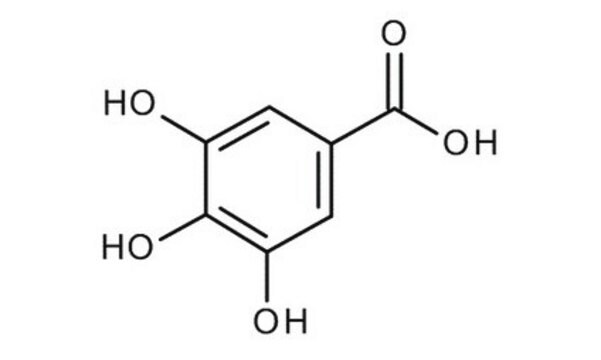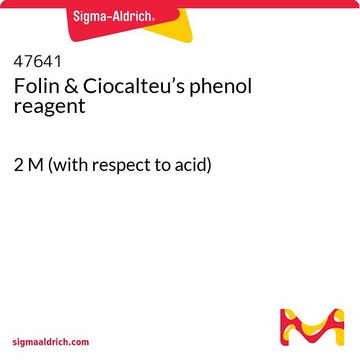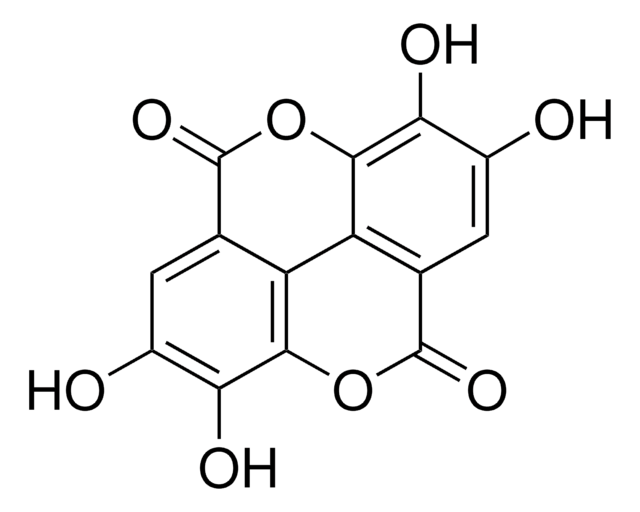G7384
Gallic acid
97.5-102.5% (titration)
Sinonimo/i:
3,4,5-Trihydroxybenzoic acid
About This Item
Prodotti consigliati
Origine biologica
plant fruit
Livello qualitativo
Saggio
97.5-102.5% (titration)
Forma fisica
powder
tecniche
HPLC: suitable
Colore
white to beige
Punto di fusione
251 °C (dec.) (lit.)
Solubilità
ethanol: 50 mg/mL, clear to slightly hazy, colorless to faintly yellow
Compatibilità
suitable for UV spectrophotometry and general use
suitable for absorption spectrum analysis
applicazioni
agriculture
metabolomics
microbiology
vitamins, nutraceuticals, and natural products
vitamins, nutraceuticals, and natural products
Stringa SMILE
OC(=O)c1cc(O)c(O)c(O)c1
InChI
1S/C7H6O5/c8-4-1-3(7(11)12)2-5(9)6(4)10/h1-2,8-10H,(H,11,12)
LNTHITQWFMADLM-UHFFFAOYSA-N
Cerchi prodotti simili? Visita Guida al confronto tra prodotti
Descrizione generale
Applicazioni
- as a standard for the quantification of extractable phenolics by external calibration
- as a standard to determine the total tannin content of oak root powder using the Folin-Ciocalteu method
- as a phenolic acid to study it′s in vitro antiviral, antibacterial, cytotoxicity and antifungal activities
Azioni biochim/fisiol
Caratteristiche e vantaggi
- High quality compound suitable for multiple research applications
- Compatible with HPLC and mass spectrometry techniques
Altre note
Avvertenze
Warning
Indicazioni di pericolo
Consigli di prudenza
Classi di pericolo
Eye Irrit. 2 - Skin Irrit. 2 - STOT SE 3
Organi bersaglio
Respiratory system
Codice della classe di stoccaggio
11 - Combustible Solids
Classe di pericolosità dell'acqua (WGK)
WGK 1
Punto d’infiammabilità (°F)
Not applicable
Punto d’infiammabilità (°C)
Not applicable
Dispositivi di protezione individuale
dust mask type N95 (US), Eyeshields, Gloves
Certificati d'analisi (COA)
Cerca il Certificati d'analisi (COA) digitando il numero di lotto/batch corrispondente. I numeri di lotto o di batch sono stampati sull'etichetta dei prodotti dopo la parola ‘Lotto’ o ‘Batch’.
Possiedi già questo prodotto?
I documenti relativi ai prodotti acquistati recentemente sono disponibili nell’Archivio dei documenti.
I clienti hanno visto anche
Articoli
Coumaric acid; Quercitrin; Myricetin; Quercetin
Protocolli
HPLC Analysis of Polyphenols in Nero d'Avola Red Wine on Discovery® HS C18 (UV 280 nm)
Coumaric acid; Quercitrin; Myricetin; Quercetin
Il team dei nostri ricercatori vanta grande esperienza in tutte le aree della ricerca quali Life Science, scienza dei materiali, sintesi chimica, cromatografia, discipline analitiche, ecc..
Contatta l'Assistenza Tecnica.









